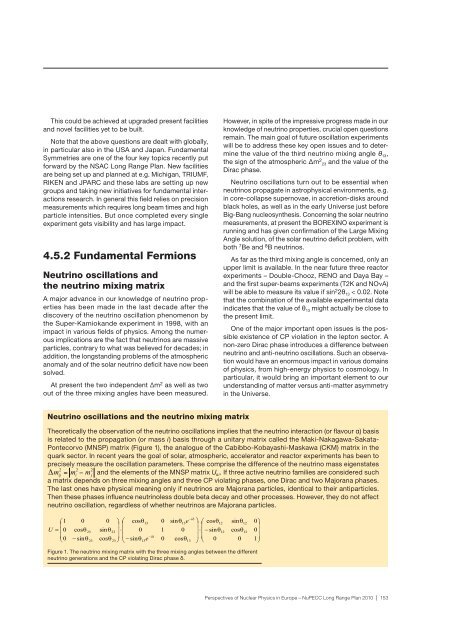Perspectives of Nuclear Physics in Europe - European Science ...
Perspectives of Nuclear Physics in Europe - European Science ...
Perspectives of Nuclear Physics in Europe - European Science ...
Create successful ePaper yourself
Turn your PDF publications into a flip-book with our unique Google optimized e-Paper software.
This could be achieved at upgraded present facilities<br />
and novel facilities yet to be built.<br />
Note that the above questions are dealt with globally,<br />
<strong>in</strong> particular also <strong>in</strong> the USA and Japan. Fundamental<br />
Symmetries are one <strong>of</strong> the four key topics recently put<br />
forward by the NSAC Long Range Plan. New facilities<br />
are be<strong>in</strong>g set up and planned at e.g. Michigan, TRIUMF,<br />
RIKEN and JPARC and these labs are sett<strong>in</strong>g up new<br />
groups and tak<strong>in</strong>g new <strong>in</strong>itiatives for fundamental <strong>in</strong>teractions<br />
research. In general this field relies on precision<br />
measurements which requires long beam times and high<br />
particle <strong>in</strong>tensities. But once completed every s<strong>in</strong>gle<br />
experiment gets visibility and has large impact.<br />
4.5.2 Fundamental Fermions<br />
Neutr<strong>in</strong>o oscillations and<br />
the neutr<strong>in</strong>o mix<strong>in</strong>g matrix<br />
A major advance <strong>in</strong> our knowledge <strong>of</strong> neutr<strong>in</strong>o properties<br />
has been made <strong>in</strong> the last decade after the<br />
discovery <strong>of</strong> the neutr<strong>in</strong>o oscillation phenomenon by<br />
the Super-Kamiokande experiment <strong>in</strong> 1998, with an<br />
impact <strong>in</strong> various fields <strong>of</strong> physics. Among the numerous<br />
implications are the fact that neutr<strong>in</strong>os are massive<br />
particles, contrary to what was believed for decades; <strong>in</strong><br />
addition, the longstand<strong>in</strong>g problems <strong>of</strong> the atmospheric<br />
anomaly and <strong>of</strong> the solar neutr<strong>in</strong>o deficit have now been<br />
solved.<br />
At present the two <strong>in</strong>dependent Δm 2 as well as two<br />
out <strong>of</strong> the three mix<strong>in</strong>g angles have been measured.<br />
However, <strong>in</strong> spite <strong>of</strong> the impressive progress made <strong>in</strong> our<br />
knowledge <strong>of</strong> neutr<strong>in</strong>o properties, crucial open questions<br />
rema<strong>in</strong>. The ma<strong>in</strong> goal <strong>of</strong> future oscillation experiments<br />
will be to address these key open issues and to determ<strong>in</strong>e<br />
the value <strong>of</strong> the third neutr<strong>in</strong>o mix<strong>in</strong>g angle θ 13 ,<br />
the sign <strong>of</strong> the atmospheric Δm 2 23 and the value <strong>of</strong> the<br />
Dirac phase.<br />
Neutr<strong>in</strong>o oscillations turn out to be essential when<br />
neutr<strong>in</strong>os propagate <strong>in</strong> astrophysical environments, e.g.<br />
<strong>in</strong> core-collapse supernovae, <strong>in</strong> accretion-disks around<br />
black holes, as well as <strong>in</strong> the early Universe just before<br />
Big-Bang nucleosynthesis. Concern<strong>in</strong>g the solar neutr<strong>in</strong>o<br />
measurements, at present the BOREXINO experiment is<br />
runn<strong>in</strong>g and has given confirmation <strong>of</strong> the Large Mix<strong>in</strong>g<br />
Angle solution, <strong>of</strong> the solar neutr<strong>in</strong>o deficit problem, with<br />
both 7 Be and 8 B neutr<strong>in</strong>os.<br />
As far as the third mix<strong>in</strong>g angle is concerned, only an<br />
upper limit is available. In the near future three reactor<br />
experiments – Double-Chooz, RENO and Daya Bay –<br />
and the first super-beams experiments (T2K and NOνA)<br />
will be able to measure its value if s<strong>in</strong> 2 2θ 13 < 0.02. Note<br />
that the comb<strong>in</strong>ation <strong>of</strong> the available experimental data<br />
<strong>in</strong>dicates that the value <strong>of</strong> θ 13 might actually be close to<br />
the present limit.<br />
One <strong>of</strong> the major important open issues is the possible<br />
existence <strong>of</strong> CP violation <strong>in</strong> the lepton sector. A<br />
non-zero Dirac phase <strong>in</strong>troduces a difference between<br />
neutr<strong>in</strong>o and anti-neutr<strong>in</strong>o oscillations. Such an observation<br />
would have an enormous impact <strong>in</strong> various doma<strong>in</strong>s<br />
<strong>of</strong> physics, from high-energy physics to cosmology. In<br />
particular, it would br<strong>in</strong>g an important element to our<br />
understand<strong>in</strong>g <strong>of</strong> matter versus anti-matter asymmetry<br />
<strong>in</strong> the Universe.<br />
Neutr<strong>in</strong>o oscillations and the neutr<strong>in</strong>o mix<strong>in</strong>g matrix<br />
Theoretically the observation <strong>of</strong> the neutr<strong>in</strong>o oscillations implies that the neutr<strong>in</strong>o <strong>in</strong>teraction (or flavour α) basis<br />
is related to the propagation (or mass i) basis through a unitary matrix called the Maki-Nakagawa-Sakata-<br />
Pontecorvo (MNSP) matrix (Figure 1), the analogue <strong>of</strong> the Cabibbo-Kobayashi-Maskawa (CKM) matrix <strong>in</strong> the<br />
quark sector. In recent years the goal <strong>of</strong> solar, atmospheric, accelerator and reactor experiments has been to<br />
precisely measure the oscillation parameters. These comprise the difference <strong>of</strong> the neutr<strong>in</strong>o mass eigenstates<br />
2 2 2<br />
mij mi m<br />
j<br />
and the elements <strong>of</strong> the MNSP matrix U α i . If three active neutr<strong>in</strong>o families are considered such<br />
a matrix depends on three mix<strong>in</strong>g angles and three CP violat<strong>in</strong>g phases, one Dirac and two Majorana phases.<br />
The last ones have physical mean<strong>in</strong>g only if neutr<strong>in</strong>os are Majorana particles, identical to their antiparticles.<br />
Then these phases <strong>in</strong>fluence neutr<strong>in</strong>oless double beta decay and other processes. However, they do not affect<br />
neutr<strong>in</strong>o oscillation, regardless <strong>of</strong> whether neutr<strong>in</strong>os are Majorana particles.<br />
Figure 1. The neutr<strong>in</strong>o mix<strong>in</strong>g matrix with the three mix<strong>in</strong>g angles between the different<br />
neutr<strong>in</strong>o generations and the CP violat<strong>in</strong>g Dirac phase δ.<br />
<strong>Perspectives</strong> <strong>of</strong> <strong>Nuclear</strong> <strong>Physics</strong> <strong>in</strong> <strong>Europe</strong> – NuPECC Long Range Plan 2010 | 153
















